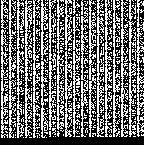Automation – Third Principle of New Media
See page 32 in The Language of New MediaThe Third Principle of New Media is introduced as follows:
“The numerical coding of media (principle 1) and the modular structure of a media object (principle 2) allow for the automation of many operations involved in media creation, manipulation and access. Thus human intentionality can be removed from the creative process, at least in part.”
Although it is certainly true that many aspects of the new media are facilitated by automated processes on computers, to identify such processes as central features or concerns of new media practices does little to clarify what aesthetic issues come into play when artists make use of the new media. To ground the discussion in what is really a material observation about the behavior of computers obscures more meaningful observations about how artists working with new media behave. It is not unlike discussing a painting in terms of how the paint dries.
The difficulty with Manovich’s approach here can be discerned in the consideration of how and why one might distinguish a new media art object made in part with automated processes on a computer from a painting made with pigments that are manufactured in automated factories; The Language of New Media contains no way to determine at what point the mediation of automated processes becomes sufficient to distinguish the new media from traditional media.
Just as it might seem odd to generalize about painters on the basis of how their pigments were manufactured, it seems odd to generalize about new media artists in terms of the automated processes they employ. While a particular artist might for some reason choose to take such processes as a thematic concern in an artwork, or adjust his or her style to the peculiarities of certain such processes, to generalize that such processes are of central concern to understanding how all other artists use a given medium would seem to generalize too much.
From the perspective of the artist, there is a certain convenience to be found in the ability of computers to automate certain types of tasks; yet in the context of new media, to identify this automation as central to the medium in a sense reduces the new media artist to a button-pusher: a consumer of automated processes rather than a creator of artworks. The effect of the assertion is similar to Truman Capote’s remark about what is perhaps Jack Kerouac’s most famous novel: “that’s not writing, that’s typing.” To diminish human intentionality in an analysis of new media is to diminish the fact that media come into use because they suit certain purposes.
It might well be argued, furthermore, that the way automation affects the behavior of the new media artist is to increase the role of human intentionality: because of the convenience with which many choices of sophisticated manipulations can be presented to a new media artist, there are more possibilities for the artist to deliberately reject. Automated processes on computers are also designed with a great deal of effort and intentionality, and there is a good deal of skill involved in learning how to make use of them – either as an artist or as a consumer.


